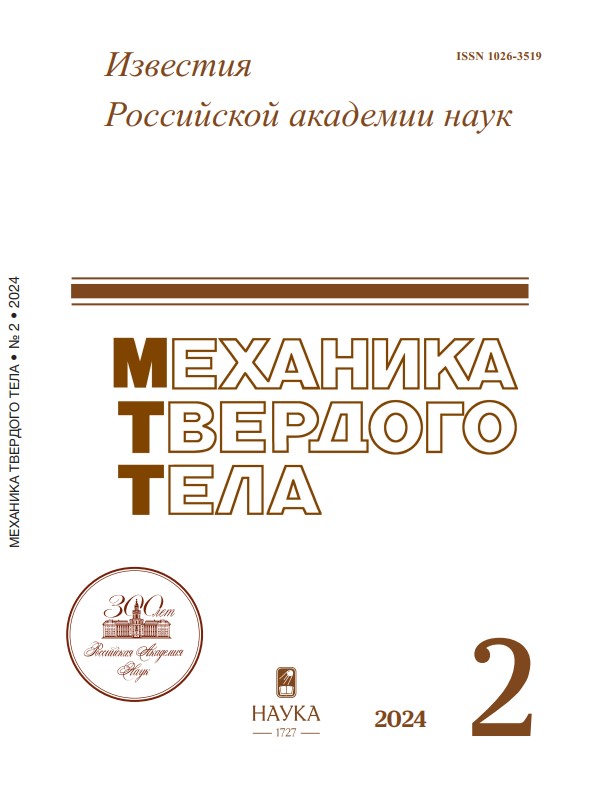On the kinetic physical and mathematical metal creep theory controlled by thermally activated dislocation sliding
- 作者: Greshnov V.M.1, Shaikhutdinov R.I.1
-
隶属关系:
- Ufa University of Science and Technology
- 期: 编号 2 (2024)
- 页面: 305-324
- 栏目: Articles
- URL: https://rjmseer.com/1026-3519/article/view/673106
- DOI: https://doi.org/10.31857/S1026351924020157
- EDN: https://elibrary.ru/uvcyqp
- ID: 673106
如何引用文章
详细
The rationale for the prospects of using the physical and mathematical theory of metal creep in creep computations is carried out by a comparative analysis of the classical phenomenological and physical and mathematical metal creep theories. On the example of the description by both theories specific results of non-stationary creep experiments and analysis of the theories equations it is shown that implementing the physical kinetic equation for the actual structural parameter of the material, namely the scalar density of immobile dislocations, makes the physical and mathematical theory universal for solving non-stationary metal creep problems with multiaxial loading, when change, including abruptly, temperature, forces and loading rates.
全文:
作者简介
V. Greshnov
Ufa University of Science and Technology
编辑信件的主要联系方式.
Email: Greshnov_VM@list.ru
俄罗斯联邦, Ufa
R. Shaikhutdinov
Ufa University of Science and Technology
Email: shaykhutdinovri@gmail.com
俄罗斯联邦, Ufa
参考
- Kachanov L.M. Theory of creep. Moscow: Fizmatgiz, 1960.
- Rabotnov Yu.N. Creep of structural elements. M.: Nauka, 1966.
- Greshnov V.M. Physico-mathematical theory of large irreversible deformations of metals // M.: Fizmatlit, 2018.
- Greshnov V.M. Physico-Mathematical Theory of High Irreversible Strains in Metals, CRC Press, 2019.
- Rumer Yu.B., Ryvkin M.Sh. Thermodynamics. Statistical physics and kinetics. Novosibirsk: Siberian University Edition, 2001. 608 p.
- Kachanov L.M. On the time of destruction under creep conditions // Izv. Academy of Sciences of the USSR. OTN. 1958. V. 8. P. 26–31.
- Rabotnov Yu.N. On the mechanism of long-term destruction // Issues of strength of materials and structures. M.: Publishing House of the USSR Academy of Sciences, 1959. P. 5–7.
- Lokoshchenko A.M. Creep and long-term strength of metals. M.: Fizmatlit, 2016.
- Malinin N. Calculations for creep of elements of mechanical engineering structures, 2nd ed., rev. and additional Textbook for bachelor’s and master’s degrees, Litres, 2022.
- Malinin N.N. Applied theory of plasticity and creep, 2020.
- Greshnov V.M., Puchkova I.V. Model of plasticity of metals under cyclic loading with large deformations // Appl. Mech. Tech. Phys. 2010. V. 51. № 2. P. 160–169.
- Greshnov V.M. Physical-mathematical theory of irreversible strains in metals // Mech. Solids. 2011. V. 46. № 4. P. 544–553.
- Greshnov V.M. et al. Mathematical modeling of multi-transition processes of cold die forging based on the physical and mathematical theory of plastic shaping of metals. Part 1. Calculation of the stress-strain state //Forging and stamping production. Metal forming. 2001. № 8. P. 33.
- Greshnov V.M. et al. Mathematical modeling of multi-transition processes of cold die forging based on the physical and mathematical theory of plastic shaping of metals. Part 2. Calculation of deformation damage and prediction of macrofracture // Forging and stamping production. Metal forming. 2001. № 10. P. 33–39.
- Greshnov V.M. Model of a viscoplastic body taking into account the history of loading // News of the Russian Academy of Sciences. Mechanics of solids. 2005. № 2. P. 117–125.
- Greshnov V.M., Pyataeva I.V., Sidorov V.E. Physico-mathematical theory of plasticity and creep of metals // Bulletin of the Ufa State Aviation Technical University. 2007. V. 9. № 6. P. 143–152.
- Greshnov V.M., Shaikhutdinov R.I., Puchkova I.V. Kinetic physical and phenomenological model of long-term strength of metals // Appl. Mech. Tech. Phys. 2017, V. 58. № 1. P. 189–198.
- Greshnov V.M., Safin F.F., Puchkova I.V. Plastic Structure Formation of the 1570R Alloy (Al–Mg–Sc) Using the Physico-Mathematical Theory of Metal Plasticity // J. Appl. Mech. Tech. Phys. 2022. V. 63. № 4. P. 669–675; https://doi.org/10.1134/S0021894422040149
- Greshnov V.M. et al. Al-Mg-Sc (1570) Alloy Structure Formation Process //Proceedings of the International Conference on Aerospace System Science and Engineering 2021, Singapore: Springer Nature Singapore, 2022. P. 547–554; https://doi.org/10.1007/978-981-16-8154-7_41
- Greshnov V.M., Shaikhutdinov R.I. Physico-phenomenological model of dislocation creep of metals // Bulletin of the Ufa State Aviation Technical University. 2013. V. 17. № 1 (54). P. 33–38.
- Ishlinsky A.Yu., Ivlev D.D. Mathematical theory of plasticity. M.: Fizmatlit, 2003. 701 p.
- Namestnikov V.S., Rabotnov Yu. N. On hereditary theories of creep // Appl. Mech. Tech. Phys. 1961. V. 2. № 4. P. 148.
- Bailey R.W. The utilization of creep test data in engineering design // Proceedings of the Institution of Mechanical Engineers. 1935. V. 131. № 1. P. 131–349.
- Oding I.A. Mechanism of creep of metals // Metallurgist. 1934. № 1.
- Namestnikov V.S., Khvostunkov A.A. Creep of duralumin under constant variable loads // Appl. Mech. Tech. Phys. 1960. № 4. P. 90–95.
补充文件













